Northern Hemisphere Extratropical Cyclone Activity in the Twentieth Century Reanalysis Version 3 (20CRv3) and Its Relationship with Continental Extreme Temperatures
Abstract
:1. Introduction
2. Analysis Data, Cyclone Activity Indices, and Diagnostic Methods
2.1. Analysis Data
2.2. Cyclone Tracking Algorithm and Cyclone Activity Indices
2.3. Diagnostic Methods
3. Cyclone Activity in 20CRv3
3.1. Climatology of Cyclone Activity
3.2. Variation of Cyclone Activity
3.3. Relationship between Regional Mean Cyclone Indices
4. Relationship of Extreme Temperatures to Regional Mean Cyclone Activity
4.1. Relations between Cyclone Activity and Continental Extreme Temperatures
4.2. The Cyclone Activity Associated Large-Scale Circulation and Temperature Advection Anomalies
5. Summary
Author Contributions
Funding
Data Availability Statement
Acknowledgments
Conflicts of Interest
References
- Ulbrich, U.; Leckebusch, G.C.; Pinto, J.G. Extra-tropical cyclones in the present and future climate: A review. Theor. Appl. Climatol. 2009, 96, 117–131. [Google Scholar] [CrossRef] [Green Version]
- Tilinina, N.; Gulev, S.K.; Rudeva, I.; Koltermann, P. Comparing cyclone life cycle characteristics and their interannual variability in different reanalyses. J. Clim. 2013, 26, 6419–6438. [Google Scholar] [CrossRef] [Green Version]
- Varino, F.; Arbogast, P.; Joly, B.; Riviere, J.; Fandeur, M.-L.; Bovy, H.; Granier, J.-B. Northern Hemisphere extratropical winter cyclones variability over the 20th century derived from ERA-20C reanalysis. Clim. Dyn. 2019, 52, 1027–1048. [Google Scholar] [CrossRef]
- Favre, A.; Gershunov, A. Extra-tropical cyclonic/anticyclonic activity in North Eastern Pacific and air temperature extremes in Western North America. Clim. Dyn. 2006, 26, 617–629. [Google Scholar] [CrossRef]
- Wang, X.L.; Swail, V.R.; Zwiers, F.W. Climatology and changes of extratropical cyclone activity: Comparison of ERA-40 with NCEP-NCAR reanalysis for 1958–2001. J. Clim. 2006, 19, 3145–3166. [Google Scholar] [CrossRef]
- Wang, X.L.; Feng, Y.; Compo, G.P.; Swail, V.R.; Zwiers, F.W.; Allan, R.J.; Sardeshmukh, P.D. Trends and low frequency variability of extra-tropical cyclone activity in the ensemble of twentieth century reanalysis. Clim. Dyn. 2013, 40, 2775–2800. [Google Scholar] [CrossRef]
- Chang, E.K.M.; Ma, C.G.; Zheng, C.; Yau, A.M.W. Observed and projected decrease in Northern Hemisphere extratropical cyclone activity in summer and its impacts on maximum temperature. Geophys. Res. Lett. 2016, 43, 2200–2208. [Google Scholar] [CrossRef] [Green Version]
- Sillmann, J.; Thorarinsdottir, T.; Keenlyside, N.; Schaller, N.; Alexander, L.V.; Hegerl, G.; Seneviratne, S.I.; Vautard, R.; Zhang, X.; Zwiers, F.W. Understanding, modeling and predicting weather and climate extremes: Challenges and opportunities. Wea. Clim. Ext. 2017, 18, 65–74. [Google Scholar] [CrossRef]
- Ulbrich, U.; Brücher, T.; Fink, A.H.; Leckebusch, G.C.; Krüger, A.; Pinto, J.G. The central European floods in August 2002: Part I—Rainfall periods and flood development. Weather 2003, 58, 371–376. [Google Scholar] [CrossRef] [Green Version]
- Ashley, W.S.; Black, A.W. Fatalities associated with nonconvective high wind events in the United States. J. Appl. Meteorol. Climatol. 2008, 47, 717–725. [Google Scholar] [CrossRef]
- Colle, B.A.; Buonaiuto, F.; Bowman, M.J.; Wilson, R.E.; Flood, R.; Hunter, R.; Mintz, A.; Hill, D. New York city’s vulnerability to coastal flooding. Bull. Am. Meteorol. Soc. 2008, 89, 829–841. [Google Scholar] [CrossRef] [Green Version]
- Fink, A.H.; Brücher, T.; Ermert, V.; Krüger, A.; Pinto, J.G. The European storm Kyrill in January 2007: Synoptic evolution, meteorological impacts and some considerations with respect to climate change. Nat. Hazards Earth Syst. Sci. 2009, 9, 405–423. [Google Scholar] [CrossRef] [Green Version]
- Pinto, J.G.; Zacharias, S.; Fink, H.; Leckebusch, G.C.; Ulbrich, U. Factors contributing to the development of extreme North Atlantic cyclones and their relationship with the NAO. Clim. Dyn. 2009, 32, 711–737. [Google Scholar] [CrossRef] [Green Version]
- Kunkel, K.E.; Easterling, D.R.; Kristovich, D.A.R.; Gleason, B.; Stoecker, L.; Smith, R. Meteorological causes of the secular variations in observed extreme precipitation events for the conterminous United States. J. Hydrometeorol. 2012, 13, 1131–1141. [Google Scholar] [CrossRef]
- Hawcroft, M.K.; Shaffrey, L.C.; Hodges, K.I.; Dacre, H.F. How much Northern Hemisphere precipitation is associated with extratropical cyclones? Geophys. Res. Lett. 2012, 39, L24809. [Google Scholar] [CrossRef] [Green Version]
- Pfahl, S.; Wernli, H. Quantifying the relevance of cyclones for precipitation extremes. J. Clim. 2012, 25, 6770–6780. [Google Scholar] [CrossRef]
- Serreze, M.C.; Carse, F.; Barry, R.G.; Rogers, J.C. Icelandic Low cyclone activity: Climatological features, linkages with the NAO and relationships with recent changes elsewhere in the Northern Hemisphere circulation. J. Clim. 1997, 10, 453–464. [Google Scholar] [CrossRef]
- Hoskins, B.J.; Hodges, K.I. New perspectives on the northernhemisphere winter storm tracks. J. Atmos. Sci. 2002, 59, 1041–1061. [Google Scholar] [CrossRef]
- König, W.; Sausen, R.; Sielmann, F. Objective identification of cyclones in GCM simulations. J. Clim. 1993, 6, 2217–2231. [Google Scholar] [CrossRef] [Green Version]
- Zhang, X.D.; Walsh, J.E.; Zhang, J.; Bhatt, U.S.; Ikeda, M. Climatology and interannual variability of arctic cyclone activity 1948–2002. J. Clim. 2004, 17, 2300–2317. [Google Scholar] [CrossRef]
- Barnes, E.A.; Screen, J.A. The impact of Arctic warming on the midlatitude jet-stream: Can it? Has it? Will it? Wiley Interdiscip Rev. Clim. Change 2015, 6, 277–286. [Google Scholar] [CrossRef] [Green Version]
- Thompson, D.W.J.; Wallace, J.M. The Arctic Oscillation signature in the wintertime geopotential height and temperature fields. Geophys. Res. Lett. 1998, 25, 1297–1300. [Google Scholar] [CrossRef] [Green Version]
- Corti, S.; Molteni, F.; Palmer, T. Signature of recent climate change in frequencies of natural atmospheric circulation regimes. Nature 1999, 398, 799–802. [Google Scholar] [CrossRef]
- Raible, C.C.; Della-Marta, P.; Schwierz, C.; Wernli, H.; Blender, R. Northern hemisphere extratropical cyclones: A comparison of detection and tracking methods and different reanalyses. Mon. Wea. Rev. 2008, 136, 880–897. [Google Scholar] [CrossRef] [Green Version]
- Neu, U.; Akperov, M.G.; Bellenbaum, N.; Benestad, R.; Blender, R.; Caballero, R.; Cocozza, A.; Dacre, H.F.; Feng, Y.; Fraedrich, K.; et al. IMILAST—A community effort to intercompare extratropical cyclone detection and tracking algorithms. Bull. Amer. Meteor. Soc. 2013, 94, 529–547. [Google Scholar] [CrossRef]
- Wang, X.L.; Feng, Y.; Chan, R.; Isaac, V. Inter-comparison of extra-tropical cyclone activity in nine reanalysis datasets. Atmos. Res. 2016, 181, 133–153. [Google Scholar] [CrossRef] [Green Version]
- Chang, E.K.M.; Yau, A.M.W. Northern Hemisphere winter storm track trends since 1959 derived from multiple reanalysis datasets. Clim. Dyn. 2015, 47, 1435–1454. [Google Scholar] [CrossRef]
- Sinclair, M.R.; Watterson, I.G. Objective assessment of extra-tropical weather systems in simulated climates. J. Clim. 1999, 12, 3467–3485. [Google Scholar] [CrossRef] [Green Version]
- Simmonds, I.; Keay, K. Mean Southern Hemisphere extratropical cyclone behavior in the 40-year NCEP–NCAR reanalysis. J. Clim. 2000, 13, 873–885. [Google Scholar] [CrossRef]
- McCabe, G.J.; Clark, M.P.; Serreze, M.C. Trends in Northern Hemisphere surface cyclone frequency and intensity. J. Clim. 2001, 14, 2763–2768. [Google Scholar] [CrossRef]
- Hodges, K.I.; Hoskins, B.J.; Boyle, J.; Thorncroft, C. A comparison of recent reanalysis datasets using objective feature tracking: Storm tracks and tropical easterly waves. Mon. Wea. Rev. 2003, 131, 2012–2037. [Google Scholar] [CrossRef]
- Rudeva, I.; Gulev, S.K. Composite analysis of North Atlantic extra-tropical cyclones in NCEP–NCAR reanalysis data. Mon. Wea. Rev. 2011, 139, 1419–1446. [Google Scholar] [CrossRef] [Green Version]
- Trigo, I.F. Climatology and interannual variability of storm-tracks in the Euro-Atlantic sector: A comparison between ERA-40 and NCEP/NCAR reanalyses. Clim. Dyn. 2006, 26, 127–143. [Google Scholar] [CrossRef]
- Bromwich, D.H.; Fogt, R.L.; Hodges, K.I.; Walsh, J.E. A tropospheric assessment of the ERA-40, NCEP, and JRA-25 global reanalyses in the polar regions. J. Geophys. Res. 2007, 112, D10111. [Google Scholar] [CrossRef] [Green Version]
- Allen, J.T.; Pezza, A.B.; Black, M.T. Explosive cyclo-genesis: A global climatology comparing multiple reanalyses. J. Clim. 2010, 23, 6468–6484. [Google Scholar] [CrossRef]
- Hodges, K.I.; Lee, R.W.; Bengtsson, L. A comparison of extra-tropical cyclones in recent reanalyses ERA-Interim, NASA MERRA, NCEP CFSR, and JRA-25. J. Clim. 2011, 24, 4888–4906. [Google Scholar] [CrossRef]
- Slivinski, L.C.; Compo, G.P.; Whitaker, J.S.; Sardeshmukh, P.D.; Giese, B.S.; McColl, C.; Allan, R.; Yin, X.; Vose, R.; Titchner, H.; et al. Towards a more reliable historical reanalysis: Improvements for version 3 of the Twentieth Century Reanalysis system. Q. J. R. Meteorol. Soc. 2019, 145, 2876–2908. [Google Scholar] [CrossRef] [Green Version]
- Slivinski, L.C.; Compo, G.P.; Sardeshmukh, P.D.; Whitaker, J.S.; McColl, C.; Allan, R.J.; Brohan, P.; Yin, X.; Smith, C.A.; Spencer, L.J.; et al. An Evaluation of the Performance of the Twentieth Century Reanalysis Version 3. J. Clim. 2021, 34, 1417–1438. [Google Scholar] [CrossRef]
- Compo, G.P.; Whitaker, J.S.; Sardeshmukh, P.D.; Matsui, N.; Allan, R.J.; Yin, X.; Gleason, B.E.; Vose, R.S.; Rutledge, G.K.; Bessemoulin, P.; et al. The twentieth century reanalysis project. Q. J. R. Meteorol. Soc. 2011, 137, 1–28. [Google Scholar] [CrossRef]
- Lei, L.; Whitaker, J.S. A four-dimensional incremental analysis update for the ensemble Kalman filter. Mon. Wea. Rev. 2016, 144, 2605–2621. [Google Scholar] [CrossRef]
- Wang, X.L.; Feng, Y.; Chan, R.; Compo, G.P.; Slivinski, L.C.; Yu, B.; Wehner, M.; Yang, X.Y. Cyclone activities as inferred from the Twentieth Century Reanalysis version 3 (20CRv3) for 1836–2015. EGU Gen. Assem. Conf. Abstr. 2020, 5885. [Google Scholar] [CrossRef]
- Dee, D.P.; Uppala, S.M.; Simmons, A.J.; Berrisford, P.; Poli, P.; Kobayashi, S.; Andrae, U.; Balmaseda, M.A.; Balsamo, G.; Bauer, P.; et al. The ERA-Interim reanalysis: Configuration and performance of the data assimilation system. Q. J. R. Meteorol. Soc. 2011, 137, 553–597. [Google Scholar] [CrossRef]
- Hersbach, H.; Bell, B.; Berrisford, P.; Hirahara, S.; Horanyi, A.; Muñoz-Sabater, J.; Nicolas, J.; Peubey, C.; Radu, R.; Schepers, D.; et al. The ERA5 global reanalysis. Q. J. R. Meteorol. Soc. 2020, 146, 1999–2049. [Google Scholar] [CrossRef]
- Armstrong, R.L.; Brodzik, M.J. An earth-gridded SSM/I data set for cryospheric studies and global change monitoring. Adv. Space Res. 1995, 16, 155–163. [Google Scholar] [CrossRef]
- Donat, M.G.; Alexander, L.V.; Yang, H.; Durre, I.; Vose, R.; Dunn, R.J.H.; Willett, K.M.; Aguilar, E.; Brunet, M.; Caesar, J.; et al. Updated analyses of temperature and precipitation extreme indices since the beginning of the twentieth century: The HadEX2 dataset. J. Geophys. Res. Atmos. 2013, 118, 2098–2118. [Google Scholar] [CrossRef]
- Serreze, M.C. Climatological aspects of cyclone development and decay in the Arctic. Atmos.-Ocean. 1995, 33, 1–23. [Google Scholar] [CrossRef]
- Bretherton, C.S.; Widmann, M.; Dymnikov, V.P.; Wallace, J.M.; Bladé, I. The effective number of spatial degrees of freedom of a time-varying field. J. Clim. 1999, 12, 1990–2009. [Google Scholar] [CrossRef]
- Yu, B.; Lin, H.; Wu, Z.; Merryfield, W. The Asian-Bering-North American teleconnection: Seasonality, maintenance, and climate impact on North America. Clim. Dyn. 2017, 50, 2023–2038. [Google Scholar] [CrossRef] [Green Version]
- Wallace, J.M.; Gutzler, D.S. Teleconnections in the geopotential height field during the Northern Hemisphere Winter. Mon. Wea. Rev. 1981, 109, 784–812. [Google Scholar] [CrossRef]
- Blackmon, M.L.; Lee, Y.H.; Wallace, J.M.; Hsu, H.H. Time variation of 500mb height fluctuations with long, intermediate, and short time scales as deduced from lag-correlation statistics. J. Atmos. Sci. 1984, 41, 981–991. [Google Scholar] [CrossRef] [Green Version]
- Gill, A.E. Atmosphere–Ocean Dynamics; Academic: London, UK, 1982; p. 662. [Google Scholar]
- Kossin, J.P.; Hall, T.; Knutson, T.; Kunkel, K.E.; Trapp, R.J.; Waliser, D.E.; Wehner, M.F. Extreme storms. In Climate Science Special Report: Fourth National Climate Assessment, Volume I; U.S. Global Change Research Program: Washington, DC, USA, 2017; pp. 257–276. [Google Scholar] [CrossRef] [Green Version]
- Knapp, K.R.; Kruk, M.C.; Levinson, D.H.; Diamond, H.J.; Neumann, C.J. The International Best Track Archive for Climate Stewardship (IBTrACS): Unifying tropical cyclone best track data. Bull. Am. Meteorol. Soc. 2010, 91, 364–376. [Google Scholar] [CrossRef]
- North, G.R.; Bell, T.L.; Cahalan, R.F.; Moeng, F.J. Sampling errors in the estimation of empirical orthogonal functions. Mon. Wea. Rev. 1982, 110, 699–706. [Google Scholar] [CrossRef]
- Yu, B.; Lin, H.; Kharin, V.V.; Wang, X.L. Interannual variability of North American winter temperature extremes and its associated circulation anomalies in observations and CMIP5 simulations. J. Clim. 2020, 33, 847–865. [Google Scholar] [CrossRef]
- Peixoto, J.; Oort, A. Physics of Climate; AIP Press: Melville, NY, USA, 1992; p. 520. [Google Scholar]
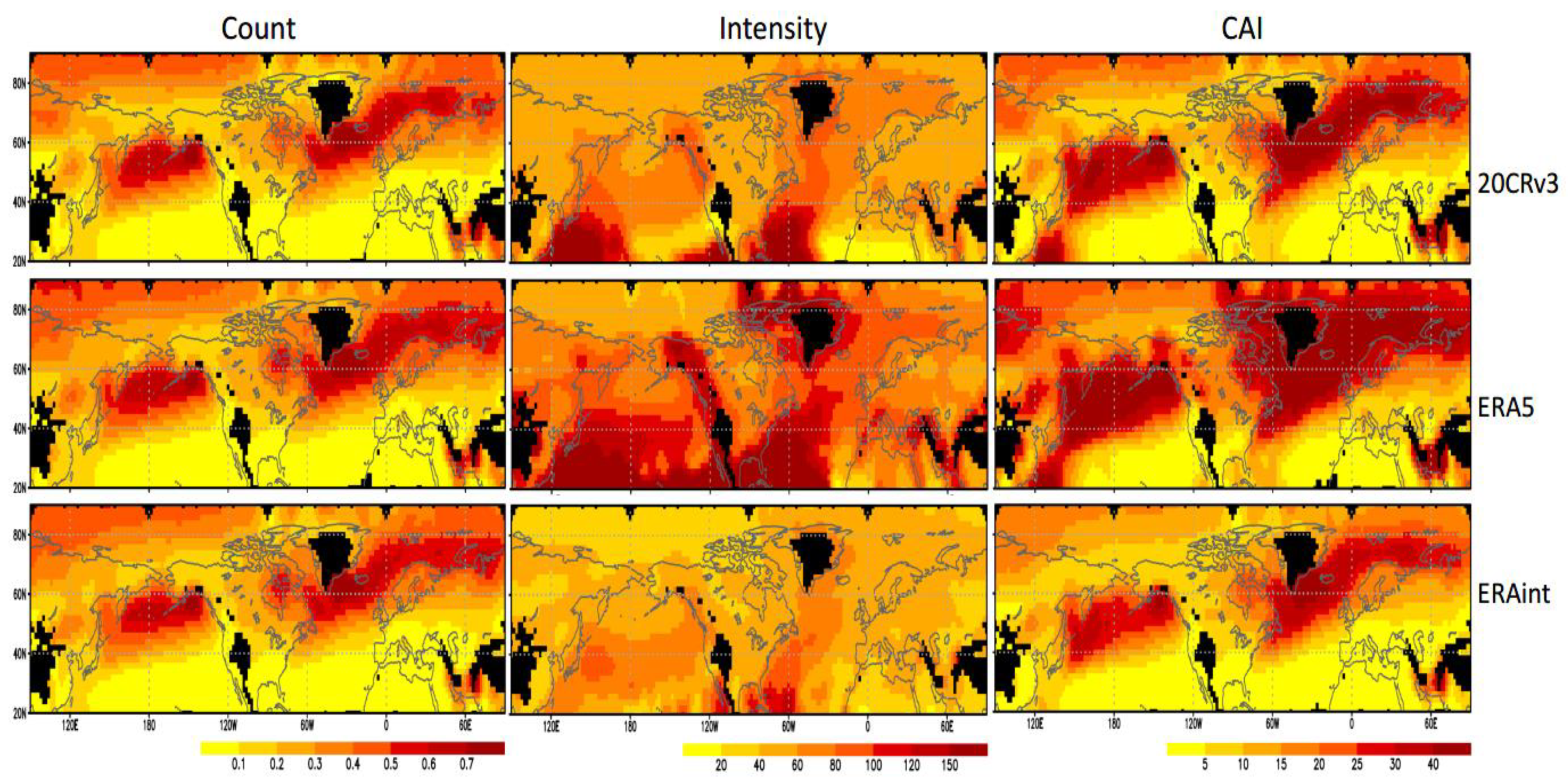
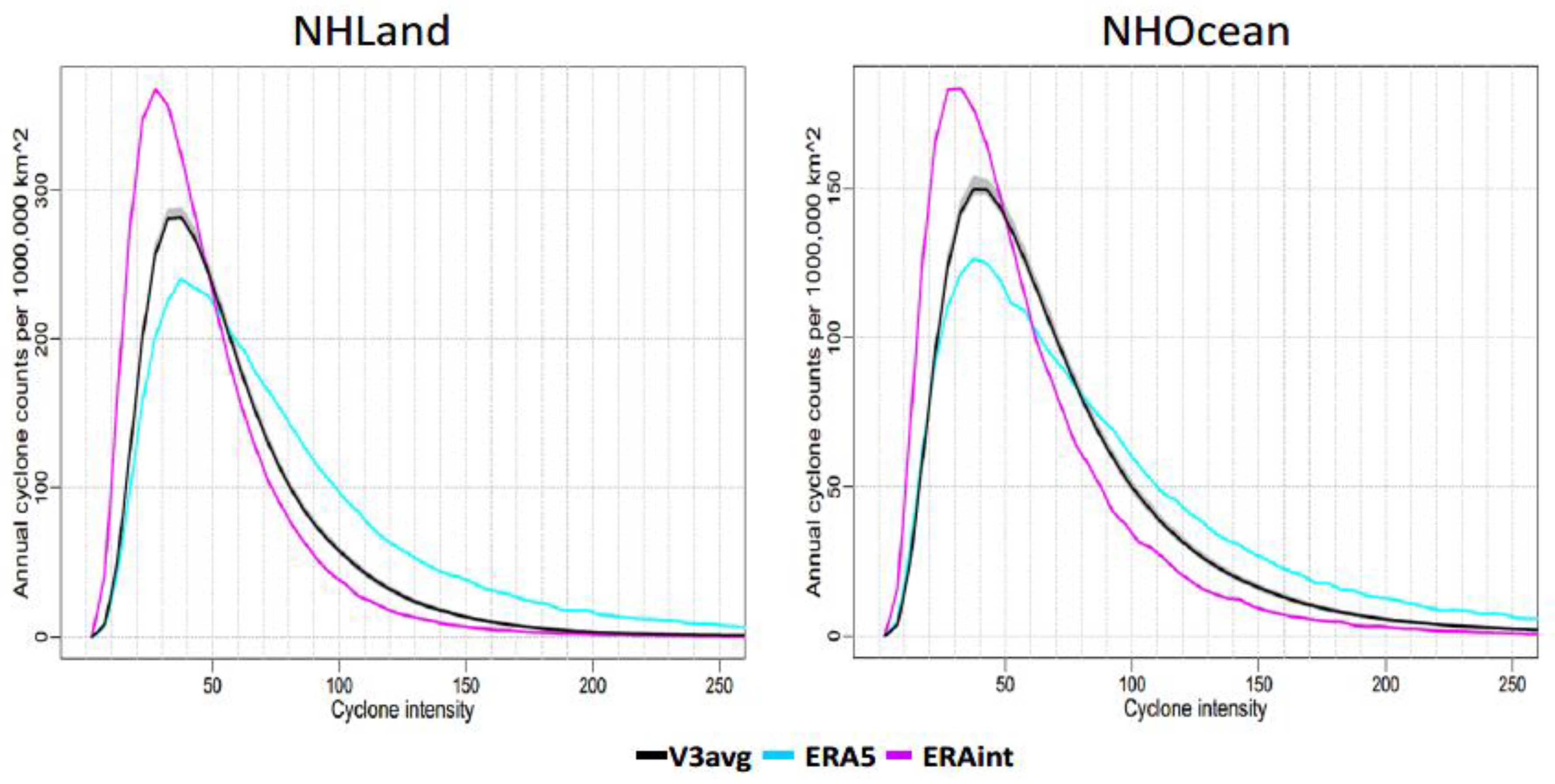
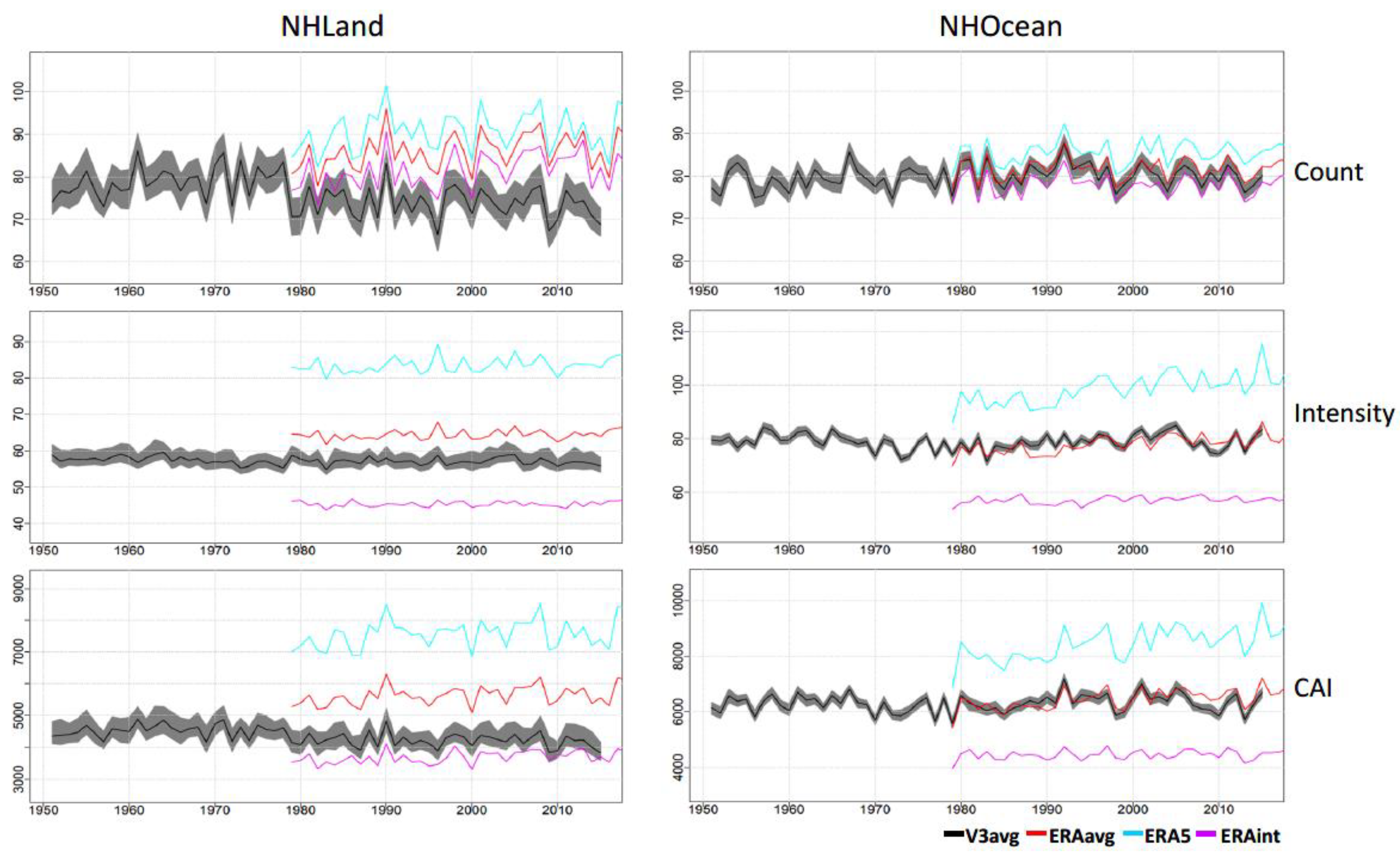


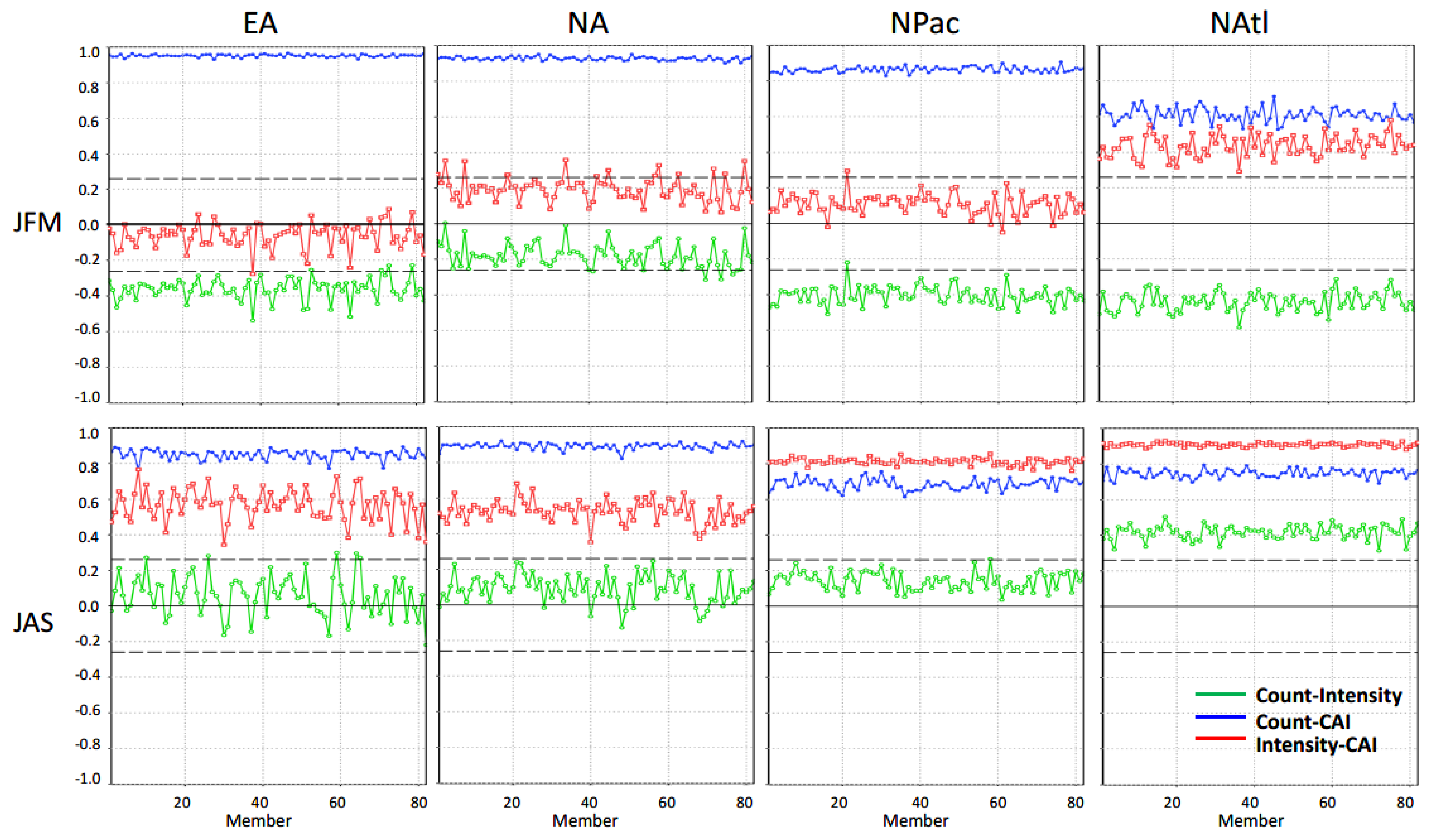
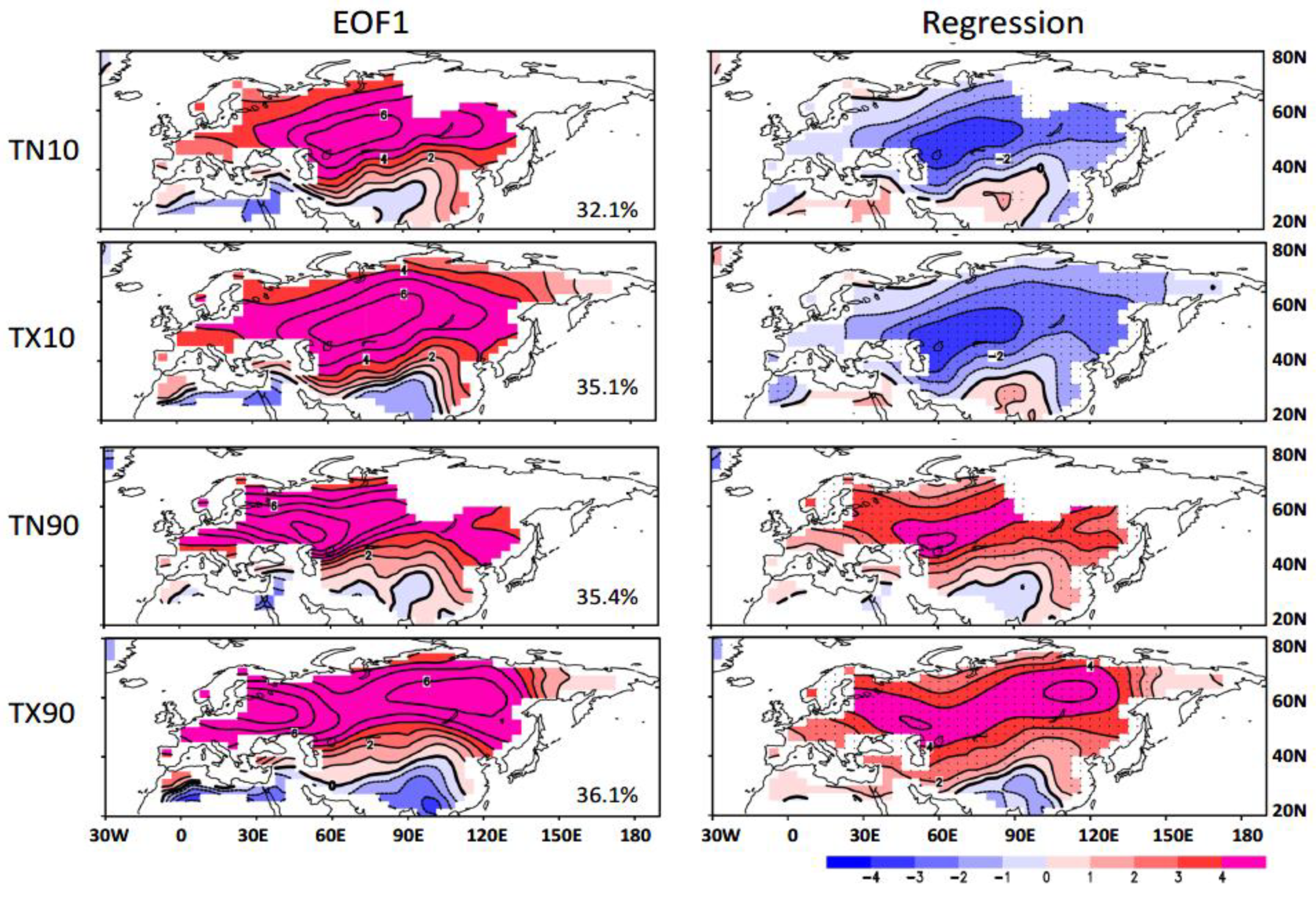
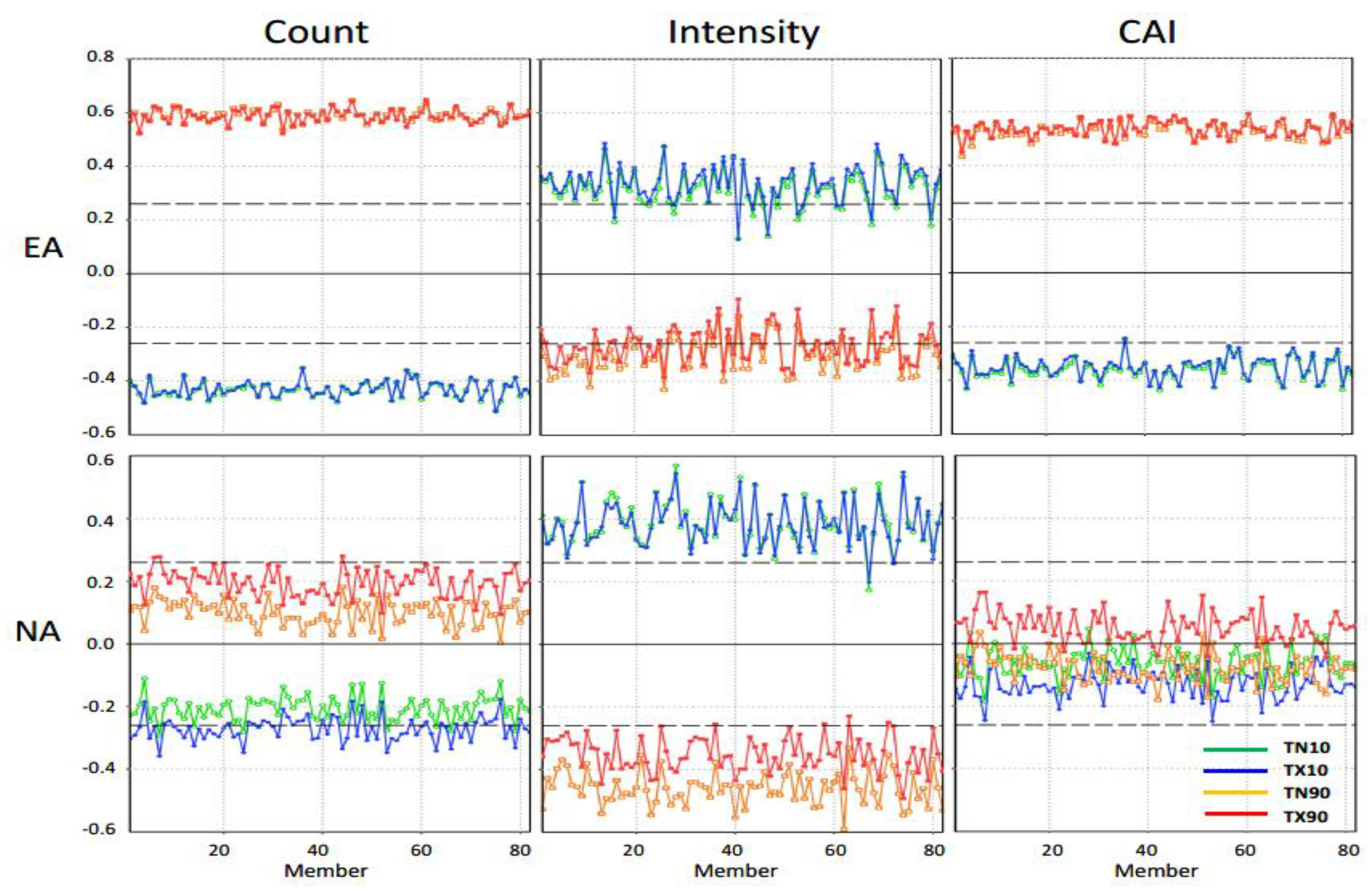


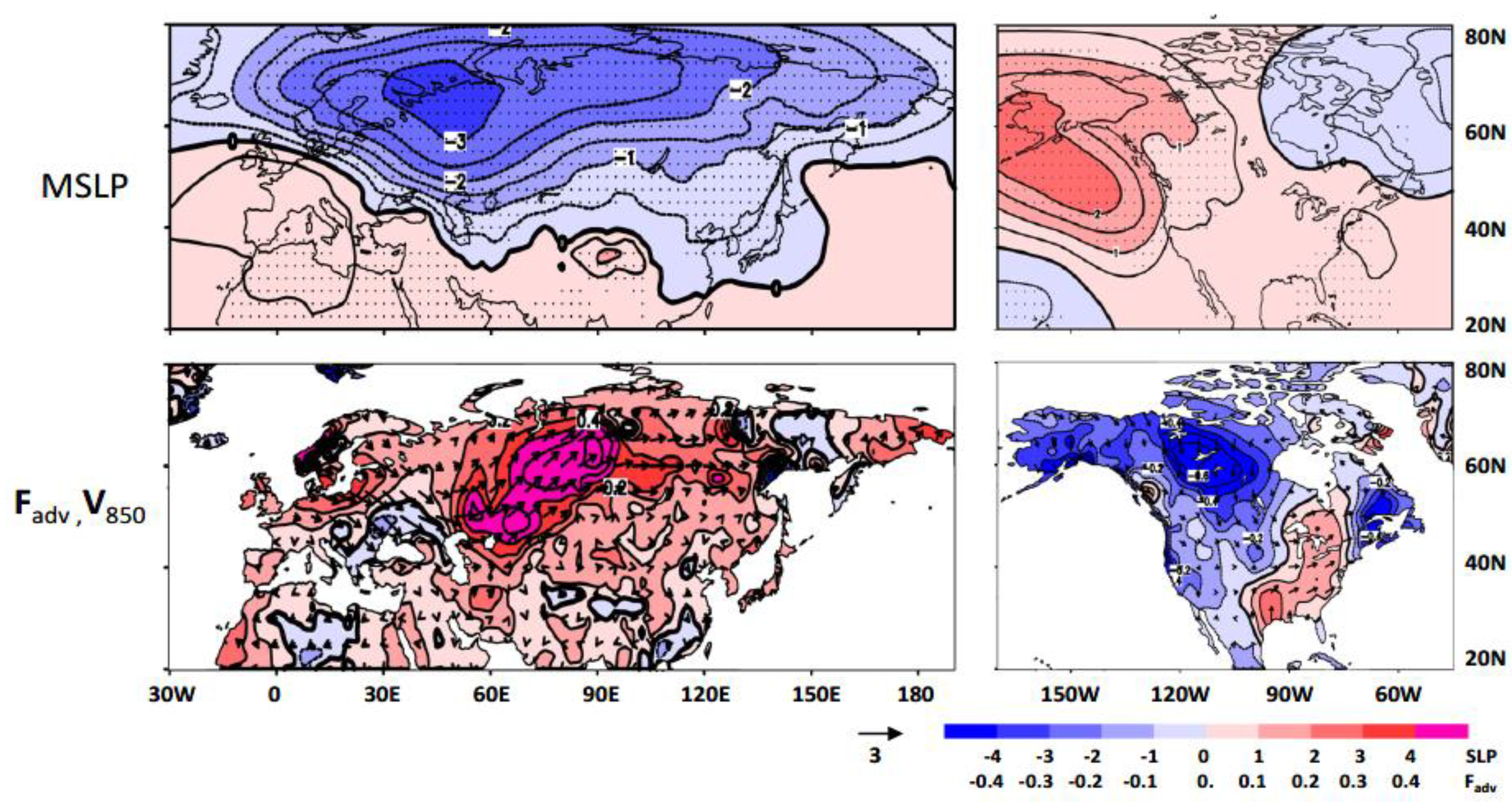
| Northern Land | Northern Ocean | ||
|---|---|---|---|
| Count | Annual | 2.1, 3.4, 2.8 | 1.1, 1.8, 1.4 |
| JFM | 2.6, 4.0, 3.2 | 2.0, 3.1, 2.4 | |
| AMJ | 3.7, 6.4, 5.1 | 2.1, 4.1, 3.2 | |
| JAS | 4.7, 7.8, 6.0 | 2.6, 4.8, 3.5 | |
| OND | 2.1, 3.7, 2.8 | 2.0, 3.3, 2.5 | |
| Intensity | Annual | 1.4, 3.0, 2.1 | 0.8, 1.2, 1.0 |
| JFM | 1.5, 2.8, 2.0 | 1.3, 1.9, 1.6 | |
| AMJ | 2.3, 7.3, 4.4 | 1.6, 2.4, 2.1 | |
| JAS | 2.9, 7.2, 4.5 | 1.8, 3.4, 2.6 | |
| OND | 1.4, 2.5, 1.8 | 1.3, 2.1, 1.7 | |
| CAI | Annual | 3.2, 5.6, 4.2 | 1.2, 2.1, 1.6 |
| JFM | 3.0, 4.7, 3.7 | 2.2, 3.6, 2.7 | |
| AMJ | 4.8, 13.0, 8.4 | 2.6, 4.6, 3.7 | |
| JAS | 7.0, 13.6, 9.2 | 2.5, 6.2, 3.6 | |
| OND | 2.5, 4.2, 3.3 | 2.1, 3.6, 2.8 |
| Count-Intensity | Count-CAI | Intensity-CAI | |
|---|---|---|---|
| EA | −0.36, 0.06, −0.43 (0.06, 0.11, −0.22) | 0.95, 0.01, 0.96 (0.85, 0.03, 0.83) | −0.06, 0.07, −0.17 (0.57, 0.09, 0.36) |
| NA | −0.18, 0.07, −0.22 (0.09, 0.08, 0.13) | 0.93, 0.01, 0.94 (0.89, 0.02, 0.90) | 0.19, 0.07, 0.12 (0.53, 0.06, 0.55) |
| NPac | −0.40, 0.05, −0.43 (0.14, 0.05, 0.18) | 0.86, 0.02, 0.87 (0.69, 0.03, 0.70) | 0.11, 0.06, 0.06 (0.81, 0.02, 0.83) |
| NAtl | −0.44, 0.05, −0.49 (0.42, 0.04, 0.47) | 0.61, 0.04, 0.57 (0.75, 0.02, 0.77) | 0.44, 0.06, 0.44 (0.91, 0.02, 0.92) |
| Count-PC1 | Intensity-PC1 | CAI-PC1 | ||
|---|---|---|---|---|
| EA | TN10 | −0.43, 0.05, −0.45 | 0.32, 0.07, 0.36 | −0.36, 0.04, −0.38 |
| TX10 | −0.43, 0.03, −0.44 | 0.34, 0.07, 0.39 | −0.35, 0.04, −0.37 | |
| TN90 | 0.59, 0.02, 0.61 | −0.30, 0.07, −0.35 | 0.53, 0.03, 0.56 | |
| TX90 | 0.59, 0.03, 0.61 | −0.28, 0.07, −0.31 | 0.54, 0.03, 0.56 | |
| NA | TN10 | −0.21,0.04, −0.22 | 0.39, 0.07, 0.45 | −0.06, 0.05, −0.07 |
| TX10 | −0.27, 0.04, −0.28 | 0.38, 0.07, 0.44 | −0.13, 0.05, −0.14 | |
| TN90 | 0.10, 0.04, 0.10 | −0.46, 0.05, −0.53 | −0.08, 0.05, −0.08 | |
| TX90 | 0.19, 0.04, 0.20 | −0.35, 0.06, −0.41 | 0.05, 0.05, 0.06 |
Publisher’s Note: MDPI stays neutral with regard to jurisdictional claims in published maps and institutional affiliations. |
© 2022 by the authors. Licensee MDPI, Basel, Switzerland. This article is an open access article distributed under the terms and conditions of the Creative Commons Attribution (CC BY) license (https://creativecommons.org/licenses/by/4.0/).
Share and Cite
Yu, B.; Wang, X.L.; Feng, Y.; Chan, R.; Compo, G.P.; Slivinski, L.C.; Sardeshmukh, P.D.; Wehner, M.; Yang, X.-Y. Northern Hemisphere Extratropical Cyclone Activity in the Twentieth Century Reanalysis Version 3 (20CRv3) and Its Relationship with Continental Extreme Temperatures. Atmosphere 2022, 13, 1166. https://doi.org/10.3390/atmos13081166
Yu B, Wang XL, Feng Y, Chan R, Compo GP, Slivinski LC, Sardeshmukh PD, Wehner M, Yang X-Y. Northern Hemisphere Extratropical Cyclone Activity in the Twentieth Century Reanalysis Version 3 (20CRv3) and Its Relationship with Continental Extreme Temperatures. Atmosphere. 2022; 13(8):1166. https://doi.org/10.3390/atmos13081166
Chicago/Turabian StyleYu, Bin, Xiaolan L. Wang, Yang Feng, Rodney Chan, Gilbert P. Compo, Laura C. Slivinski, Prashant D. Sardeshmukh, Michael Wehner, and Xiao-Yi Yang. 2022. "Northern Hemisphere Extratropical Cyclone Activity in the Twentieth Century Reanalysis Version 3 (20CRv3) and Its Relationship with Continental Extreme Temperatures" Atmosphere 13, no. 8: 1166. https://doi.org/10.3390/atmos13081166
APA StyleYu, B., Wang, X. L., Feng, Y., Chan, R., Compo, G. P., Slivinski, L. C., Sardeshmukh, P. D., Wehner, M., & Yang, X.-Y. (2022). Northern Hemisphere Extratropical Cyclone Activity in the Twentieth Century Reanalysis Version 3 (20CRv3) and Its Relationship with Continental Extreme Temperatures. Atmosphere, 13(8), 1166. https://doi.org/10.3390/atmos13081166







